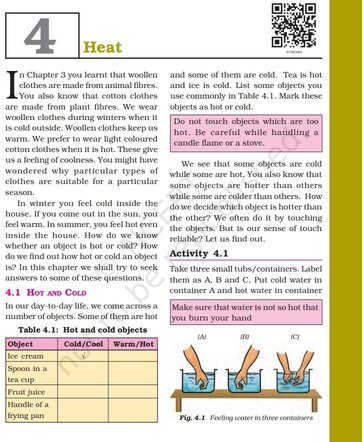Chapter 4 (Heat) of Class 7 Science NCERT Book (PDF) is available here for download in PDF format. Download and prepare for CBSE Class 7 Science exam. It is one of the most important chapters of CBSE Class 7 Science NCERT textbook and many important questions are framed from this chapter.
Heat - Chapter 4: Class 7 Science NCERT Book (PDF): Download Now
A Snapshot of Class 7 Science NCERT Book (PDF) Chapter 4:
Important topics of this chapter:
⇒ Hot & cold objects
⇒ Hot & Cold
⇒ Temperature
⇒ Thermometer
⇒ Measurement Temperature
⇒ Clinical thermometer
⇒ Reading a thermometer
⇒ The normal temperature of the human body is 37°C
⇒ Laboratory Thermometer
⇒ Conduction
⇒ The materials which allow heat to pass through them easily are conductors of heat.
⇒ Poor conductors are known as insulators
⇒ This mode of heat transfer is known as convection
⇒ The air from the sea is called the sea breeze
⇒ This is called the land breeze
⇒ The sun the heat comes to us by another process known as radiation
⇒ Woollen clothes keep us warm in winter
⇒ Our sense of touch is not always a reliable guide to the degree of hotness of an object.
⇒ Temperature is a measure of the degree of hotness of an object.
⇒ Thermometer is a device used for measuring temperature.
⇒ Clinical thermometer is used to measure our body temperature. The range of this thermometer is from 35°C to 42°C. For other purposes, we use laboratory thermometers. The range of these thermometers is usually from –10°C to 110°C.
⇒ The normal temperature of the human body is 37°C.
⇒ The heat flows from a body at a higher temperature to a body at a lower temperature. There are three ways in which heat can flow from one object to another. These are conduction, convection and radiation.
⇒ In solids, generally, the heat is transferred by conduction. In liquids and gases the heat is transferred by convection. No medium is required for transfer of heat by radiation.
⇒ The materials which allow heat to pass through them easily are conductors of heat.
⇒ The materials which do not allow heat to pass through them easily are called insulators.
⇒ Dark-coloured objects absorb more heat than the light-coloured objects.
⇒ That is the reason we feel more comfortable in light-coloured clothes in the summer.
⇒ Woollen clothes keep us warm during winter. It is so because wool is a poor conductor of heat and it has air trapped in between the fibres.
Heat - Chapter 4: Class 7 Science NCERT Book (PDF)
Chapter 4 (Heat) of Class 7 Science NCERT Book (PDF) is available here for download in PDF format. Download & prepare for CBSE Class 7 Science exam.
Comments
All Comments (0)
Join the conversation